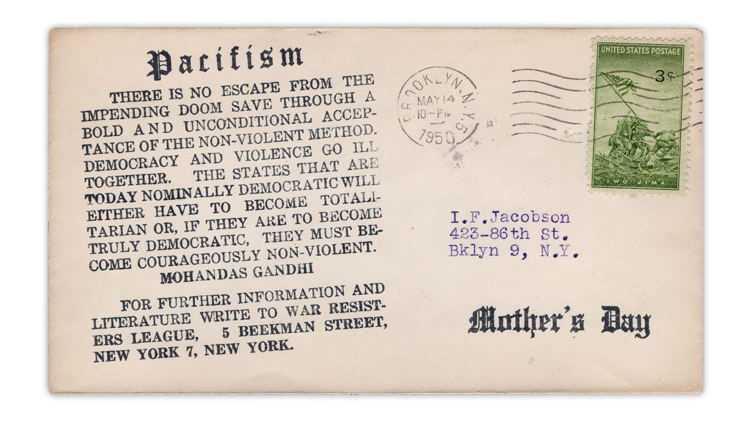US Stamps
Pacifism on cover and Korean War mail

U.S. Stamp Notes by John. M. Hotchner
It was May 1950, just about a month before the United States was again plunged into war, this time on the Korean Peninsula, and the War Resister’s League was sending literature trying to encourage people to “Think Peace,” as can be seen on the cover pictured here.
Curiously, the league was franking its envelopes with the United States 1945 3¢ Iwo Jima commemorative (Scott 929).
With the terrible specter of the destructive power of the atomic bomb in our heads, peace looked ever more desirable.
Unfortunately, however noble the movement, we humans are an imperfect lot with aggression, acquisitiveness and a penchant for resolving grievances through war built in.
Thus, at 4 a.m. on June 25, 1950, the North Korean Peoples’ Army crossed the 38th parallel that divided the two Koreas, with the object of unifying the country under communist rule. They almost succeeded and would have but for a rapid appeal to the United Nations by President Harry Truman.
The United Nations rapidly resolved to oppose the North Korean invasion via Security Council resolutions 82 and 83 of June 25 and June 27, 1950.
The Soviet Union did not exercise its veto power because its delegate was boycotting the meetings to protest the fact that the Peoples’ Republic of China had no representation at the United Nations.
Ultimately, 21 U.N. member countries sent troops or support forces to counter the invasion from the north.
By Oct. 1, 1950, the North Korean Peoples’ Army had been driven out of South Korea, and U.N. forces kept going north hoping to unite the peninsula under the South Korean government.
By Oct. 26, they had reached well into the north and were advancing toward the Chinese border. In November, the Chinese, hostile to the idea of having a U.S.-sponsored democracy on its southern border, entered North Korea to drive the U.N. forces out and to support the original North Korean Peoples’ Army objective.
To make a long story short, after initial successes, the Chinese advance was stopped, and they were pushed back to the 38th parallel in March 1951. There ensued two more years of see-saw battles on either side of the 38th parallel before an armistice in July 1953 ended open hostilities.
The state of war between the two occupants of the peninsula remains to this day.
To continue reading this column, subscribe to Linn’s Stamp News.
Connect with Linn’s Stamp News:
Sign up for our newsletter
Like us on Facebook
Follow us on Twitter
MORE RELATED ARTICLES
Headlines
-
US Stamps
Oct 7, 2024, 12 PMVasiliauskas named president of Mystic Stamp Co.
-
US Stamps
Oct 6, 2024, 5 PMApgar souvenir card available
-
US Stamps
Oct 6, 2024, 4 PMFirst Continental Congress and U.N. stamps receive Scott catalog numbers
-
World Stamps
Oct 5, 2024, 1 PMCanada Post continues Truth and Reconciliation series








